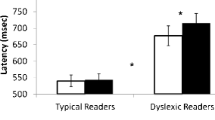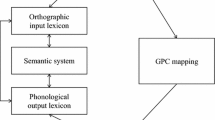Abstract
Hyperlexia is a syndrome of reading without meaning in individuals who otherwise have pronounced cognitive and language deficits. The present study investigated the quality of word representation and the effects of deficient semantic processing on word and nonword reading of Korean children with hyperlexia; their performances were compared to those of typical children matched for their word-recognition abilities. In Study 1, both groups of children were tested on their ability to read word-like nonwords (nonsense words that are generated from real words). Typical children showed slower read-aloud times when reading word-like nonwords compared to real words; children with hyperlexia showed no significant differences between the two types of words. These results suggest that typical children were disrupted by information from the baseword (e.g., ‘self’) on which the nonword is based (e.g., ‘melf’) when reading word-like nonwords, whereas children with hyperlexia were not interrupted by such information. In Study 2, the same two groups were compared on their word reading performances between semantically related picture-word versus semantically unrelated picture-word pairs. Typical children read more slowly the words preceded by semantically related pictures than the words preceded by semantically unrelated pictures; children with hyperlexia read both picture-word pairs at a comparable rate. These results imply that, during word reading, typical children were affected by semantic information from the preceding picture unlike children with hyperlexia who were not influenced by the preceding semantic information. These findings from Study 1 and Study 2 are discussed in relation to the connectionist models of reading.



Similar content being viewed by others
Notes
The nonword가기/kagi/can be used as a real word in some contexts (e.g., 바로 가기). Therefore, the analyses were repeated after excluding the nonword 가기. The same results were obtained when the analysis was repeated on the mean error rate. Almost identical results were obtained when the analysis was repeated on the reading time (a significant main effect of WordType, F(1,18) = 7.63, p = .013, η 2p = .30; a significant WordType-Group interaction, F(1, 18) = 7.52, p = .013, η 2p = .30); non-significant main effect of Group, F(1, 18) = 3.61, p = .073). Post-hoc test results also revealed the same patterns: while the children without hyperlexia read words significantly faster than nonwords (t(9) = −3.185, p = .011, d = −1.04), the children with hyperlexia did not (t(9) = .020, p = .984).
References
Adams, M. J. (2000). Beginning to read: Thinking and learning about print. Cambridge, MA: The Massachusetts Institute of Technology Press.
Aram, D. M. (1997). Hyperlexia: Reading without meaning in young children. Topics in Language Disorders, 17, 1–13.
Aram, D. M., & Healy, J. M. (1988). Hyperlexia: A review of extraordinary word recognition. In L. K. Obler & D. Fein (Eds.), The exceptional brain: Neuropsychology of talent and special abilities (pp. 70–102). New York: Guilford Press.
Aram, D. M., Rose, D. F., & Horwitz, S. J. (1984). Hyperlexia: Developmental reading without meaning. In R. Malatesha & H. A. Whitaker (Eds.), Dyslexia: A global issue (pp. 517–531). The Hague: Martinus Nijhoff.
Becker, C. A. (1980). Semantic context effects in visual word recognition: An analysis of semantic strategies. Memory & Cognition, 8, 493–512.
Burd, L., Kerbeshian, J., & Fisher, W. (1985). Inquiry into the incidence of hyperlexia in a statewide population of children with pervasive developmental disorder. Psychological Reports, 57, 236–238.
Cardoso-Martins, C., & Silva, J. R. (2010). Cognitive and language correlates of hyperlexia: Evidence from children with autism spectrum disorders. Reading and Writing, 23, 129–145.
Castles, A., & Coltheart, M. (1993). Varieties of developmental dyslexia. Cognition, 47, 149–180.
Catts, H., Hogan, T. P., & Fey, M. (2003). Subgrouping poor readers on the basis of reading-related abilities. Journal of Learning Disabilities, 36, 151–164.
Choi, H. P., Kwak, K., & Park, K. (1996). Korean-Wechsler Preschool and Primary Scale of Intelligence. Seoul: Special education.
Cohen, M. J., Hall, J., & Riccio, C. A. (1997). Neuropsychological profiles of children diagnosed as specific language impaired with and without hyperlexia. Archives of Clinical Neuropsychology, 12, 223–229.
Coltheart, M. (1978). Lexical access in simple reading tasks. In G. Underwood (Ed.), Strategies of Information Processing (pp.151–216). London: Academic Press.
Coltheart, M. (2006). Dual route and connectionist models of reading: An overview. London Review of Education, 4(1), 5–17.
Forster, K. L., & Forster, J. C. (n. d.). DMDX display software. Retrieved from http://www.u.arizona.edu/~kforster/dmdx/dmdx.htm.
Glosser, G., Friedman, R. B., & Roeltgen, D. P. (1996). Clues to the cognitive organization of reading and writing from developmental hyperlexia. Neuropsychology, 10, 168–175.
Goldberg, T. E., & Rothermel, R. D. (1984). Hyperlexic children reading. Brain, 107, 759–785.
Healy, J. M. (1982). The enigma of hyperlexia. Reading Research Quarterly, 17, 319–339.
Healy, J. M., Aram, D. M., Horwitz, S. J., & Kessler, J. W. (1982). A study of hyperlexia. Brain and Language, 17, 1–23.
Hutchison, K. A. (2003). Is semantic priming due to association strength or featural overlap? A micro-analytic review. Psychonomic Bulletin & Review, 10, 785–813.
Joshi, R. M., Padakannaya, P., & Nishanimath, R. (2010). Dyslexia and hyperlexia in bilinguals. Dyslexia, 16, 99–118.
Kennedy, B. (2003). Hyperlexia profiles. Brain and Language, 84(2), 204–221.
Kim, J., & Davis, C. (2004). Characteristics of poor readers of Korean Hangul: Auditory, visual, and phonological processing. Reading & Writing: An Interdisciplinary Journal, 17, 153–185.
Kim, Y. T., Seong, T. J., & Lee, Y. K. (2003). Preschool Receptive-Expressive Language Scale (PRES). Seoul: Seoul Community Rehabilitation Center.
Korean Educational Development Institute. (1989). KEDI-Individual Basic Learning Skills Test (KEDI). Seoul: Korean Educational Development Institute.
Laxon, V. J., Coltheart, V., & Keating, C. (1988). Children find friendly words friendly too: Words with many orthographic neighbors are easier to read and spell. British Journal of Educational Psychology, 58, 103–111.
Lucas, M. (2000). Semantic priming without association: A meta-analytic review. Psychonomic Bulletin & Review, 7, 618–630.
McClelland, J. L., & Rumelhart, D. E. (1981). An interactive activation model of the effect of context in perception, Part I. An account of basic findings. Psychological Review, 88, 375–407.
Meyer, D. E., Schvaneveldt, R. W., & Ruddy, M. G. (1975). Loci of contextual effects on visual word recognition. In S. Dornic (Ed.), Attention and Performance VI (Vol. 5, pp. 98–118). New York: Lawrence Erlbaum Associates.
Murphy, K., McKone, E., & Slee, J. (2003). Dissociations between implicit and explicit memory in children: The role of strategic processing and the knowledge base. Journal of Experimental Child Psychology, 84, 124–165.
Nam, M., & Park, R. (2002).Comparison between pervasive developmental disorder and developmental delayed children with hyperlexia. Paper session presented at the Ninth Conference of Korean Association for Persons with Autism, Seoul, Korea.
Nation, K. (1999). Reading skills in hyperlexia: A developmental perspective. Psychological Bulletin, 125, 338–355.
Nation, K., & Snowling, M. (1998). Contextual facilitation of word recognition: Evidence from dyslexia and poor reading comprehension. Child Development, 69, 996–1011.
Nation, K., & Snowling, M. J. (1999). Developmental differences in sensitivity to semantic relations among good and poor comprehenders: Evidence from semantic priming. Cognition, 70, B1–B13.
Newman, T. M., Macomber, D., Babitz, T., Volkmar, F., & Grigorenko, E. L. (2007). Hyperlexia in children with autism spectrum disorders. Journal of Autism and Developmental Disorders, 37, 760–774.
Nippold, M. A. (2002). Lexical learning in school-age children, adolescents, and adults: a process where language and literacy converge. Journal of Child Language, 29(02), 449–488.
Park, E., Hwang, M., & Nam, M. (2003). The reading skills and language and cognitive characteristics of children with hyperlexia. Korean Journal of Communication Disorders, 8(1), 82–99.
Patti, P. J., & Lupinetti, L. (1993). Brief report: Implications of hyperlexia in an autistic savant. Journal of Autism and Developmental Disorders, 23, 397–405.
Pennington, B. P., Johnson, C., & Welsh, M. C. (1987). Unexpected reading precocity in a normal preschooler: Implications for hyperlexia. Brain and Language, 30, 165–180.
Plaut, D. C. (1999). A connectionist approach to word reading and acquired dyslexia: Extension to sequential processing. Cognitive Science, 23, 543–568.
Plaut, D. C., McClelland, J. L., Seidenberg, M. S., & Patterson, K. (1996). Understanding normal and impaired word reading: Computational principles in quasi-regular domains. Psychological Review, 103, 56–115.
Richman, L. C., & Kitchell, M. M. (1981). Hyperlexia as a variant of developmental language disorder. Brain and Language, 12, 203–212.
Saldaña, D., Carreiras, M., & Frith, U. (2009). Orthographic and phonological pathways in hyperlexic readers with autism spectrum disorders. Developmental Neuropsychology, 34(3), 240–253.
Schacter, D. L., Chiu, C. Y. P., & Ochsner, K. N. (1993). Implicit memory: A selective review. Annual Review of Neuroscience, 16, 156–182.
Schwartz, M. F., Marin, O. S. M., & Saffran, E. M. (1979). Dissociations of language function in dementia: A case study. Brain and Language, 7, 277–306.
Schwartz, M. F., Saffran, E. M., & Marin, O. S. M. (1980). Fractionating the reading process: Evidence for word-specific, print-to-sound associations. In M. Coltheart, K. Patterson, & J. C. Marshall (Eds.), Deep dyslexia (pp. 259–269). London: Routledge & Kegan Paul.
Seidenberg, M. S. (2007). Connectionist models of reading. Current Directions in Psychological Science, 14, 238–242.
Seidenberg, M. S., & McClelland, J. L. (1989). A distributed, developmental model of word recognition and naming. Psychological Review, 96, 523–568.
Seidenberg, M. S., & Plaut, D. C. (1998). Evaluating word reading models at the item level: Matching the grain of theory and data. Psychological Science, 9, 234–237.
Siegel, L. S. (1984). A longitudinal study of a hyperlexic child: Hyperlexia as a language disorder. Neuropsychologia, 22, 557–585.
Silberberg, N., & Silberberg, M. C. (1971). Hyperlexia: The other end of the continuum. Journal of Special Education, 5, 233–242.
Sparks, R. L. (2001). Phonemic awareness and reading skills in hyperlexic children: A longitudinal study. Reading and Writing: An Interdisciplinary Journal, 14, 333–360.
Sternberg, R. J., & Powell, J. S. (1983). Comprehending verbal comprehension. American Psychologist, 38, 878–893.
Stothard, S. E., Snowling, M. I., Bishop, D. V. M., Chipchase, B. B., & Kaplan, C. A. (1998). Language impaired pre-schoolers: A follow-up into adolescence. Journal of Speech, Language and Hearing Research, 41, 407–418.
Treiman, R., Goswami, U., & Bruck, M. (1990). Not all nonwords are alike: Implications for reading development and theory. Memory and Cognition, 18, 559–567.
Tulving, E., & Schacter, D. L. (1990). Priming and human memory systems. Science, 247, 301–306.
Welsh, M. C., Pennington, B. F., & Rogers, S. (1987). Word recognition and comprehension skills in hyperlexic children. Brain and Language, 32, 76–96.
West, R. F., Stanovich, K. E., Feeman, D., & Cunningham, A. (1983). The effect of sentence context on word recognition in second- and sixth-grade children. Reading Research Quarterly, 19, 6–15.
Author information
Authors and Affiliations
Corresponding author
Rights and permissions
About this article
Cite this article
Lee, S.H., Hwang, M. Word and nonword processing without meaning support in Korean-speaking children with and without hyperlexia. Read Writ 28, 217–238 (2015). https://doi.org/10.1007/s11145-014-9522-3
Published:
Issue Date:
DOI: https://doi.org/10.1007/s11145-014-9522-3




